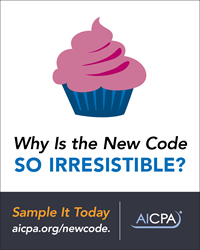AICPA Ethics Codification Project

The AICPA’s Professional Ethics Executive Committee (PEEC) restructured the Institute’s ethics standards to improve the AICPA Code of Professional Conduct (Code) so that members and others can apply the rules and reach correct conclusions more easily and intuitively.
To achieve this, PEEC restructured the Code into several parts each organized by topic, edited the Code using consistent drafting and style conventions, incorporated a conceptual framework for members in public practice and in business, revised certain Code provisions to reflect the "conceptual framework" approach (also known as the "threats and safeguard" approach) and where applicable, referenced existing non-authoritative guidance to the relevant topic.
In addition, a new dynamic online platform was developed to house the Code. This platform allows users to quickly navigate the code, conduct searches and also contains personalization features. The new Code is effective December 15, 2014 with early adoption encouraged.
Revised Code
The revised code will be officially launched online on June 2nd pub.aicpa.org/codeofconduct and is effective December 15, 2014 with early adoption encouraged.
The updated code lives on a new and dynamic online platform that not only allows the user to conduct and save basic and advanced searches but also includes the ability to email links, create and name bookmarks and add and save notes while reviewing the code. In addition, the online platform features pop-ups for defined terms as well as hyperlinks connecting to other relevant content within the code as well as external non-authoritative material issued by staff of the Ethics Division.
Hot Topics

The most significant change to the content in the revised AICPA Code is the incorporation of two conceptual frameworks, one for members in public practice and one for members in business. The conceptual framework approach is a way of identifying, evaluating and addressing threats to compliance with the rules resulting from a specific relationship or circumstance that is not otherwise addressed in the code.

To assist with implementing the revised AICPA Code several documents are available including a mapping document.
Visit the Ethics Codification Tools page for more information.

